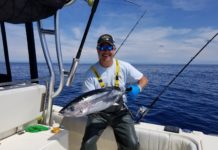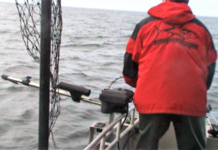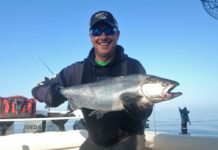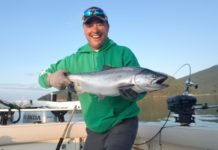
Munidopsis albatrossae, a blind “squat lobster,” lives at depths up to 2,500 meters. Because there is no light at this depth, they would have little use for eyes and therefore have none. Image courtesy of Exploring Alaska’s Seamounts 2002, NOAA/OER.
The importance of light in the ocean is reflected by the description of the ocean’s vertical zones of the water column in terms of how much light they receive. The ocean is generally divided into three named zones: the photic (or epipelagic), twilight (or mesopelagic), and midnight (bathypelagic) zones.
The upper 200 meters of the ocean is called the epipelagic or photic zone. Sunlight penetrates this zone sufficiently to support the growth of phytoplankton and/or macro algae (i.e., plants that need sunlight to make food and survive). Limits to primary production are often low nutrient levels since mineral nutrients are consumed by producers that die and sink, removing them from the surface waters. Nutrients must be replaced by re-circulation of deeper ocean water or run-off from land.
Ocean primary production is largely restricted to the epipelagic zone. Organisms in the zones below are dependent on what food drifts down from above, ranging from tiny clumps of bacteria and dead algae to occasional bonanzas like a dead whale.
The area between 200 and 1,000 meters is the mesopelagic or “twilight” zone. Light intensity in this zone is severely reduced with increasing depth, so light penetration is minimal. When one looks up toward the surface with dark-adapted eyes, enough light can be seen so that organisms living here have adaptations that help obscure their outline against the surface. About 20 percent of primary production from the surface is falls down to the mesopelagic zone. Consequently, the density or biomass of mesopelagic zone occupants is lower than at the surface, and mesopelagic organisms have an interesting variety of mechanisms that help them find food as well as avoid being meals for other species.
Sunlight does not penetrate the eternal darkness below 1,000 meters, an area known as the bathypelagic zone. Popular sources sometimes refer to this as the midnight zone. About five percent of the primary production from the surface makes it to the bottom of the ocean. Less food means lower biomass. Occasionally, large items like dead sharks or whales reach the seafloor, but generally food is scarce.
For More Information:
Ocean Zones (pdf, 434 kb), Learning Science through Ocean Exploration
Exploring Ocean Zones, Multimedia Discovery Missions
Entering the Twilight Zone (pdf, 183 kb), Chemosynthetic Life in the Gulf of Mexico 2002
Sign up for the Ocean Explorer E-mail Update List.














